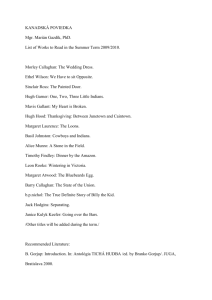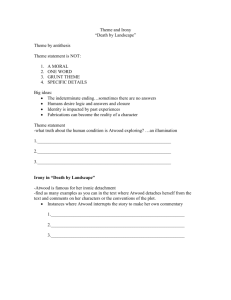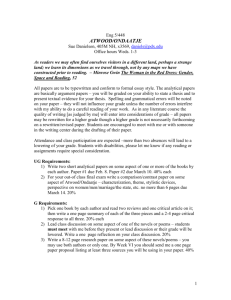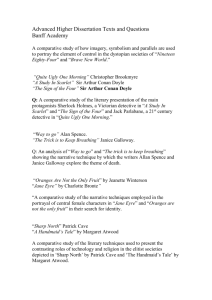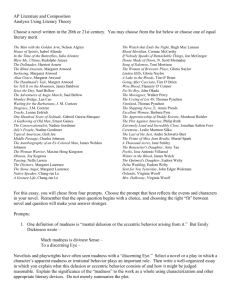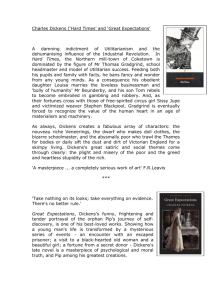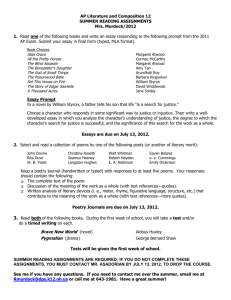B05E123 A Study of Margaret Atwood: The Spiritual Quest in
advertisement
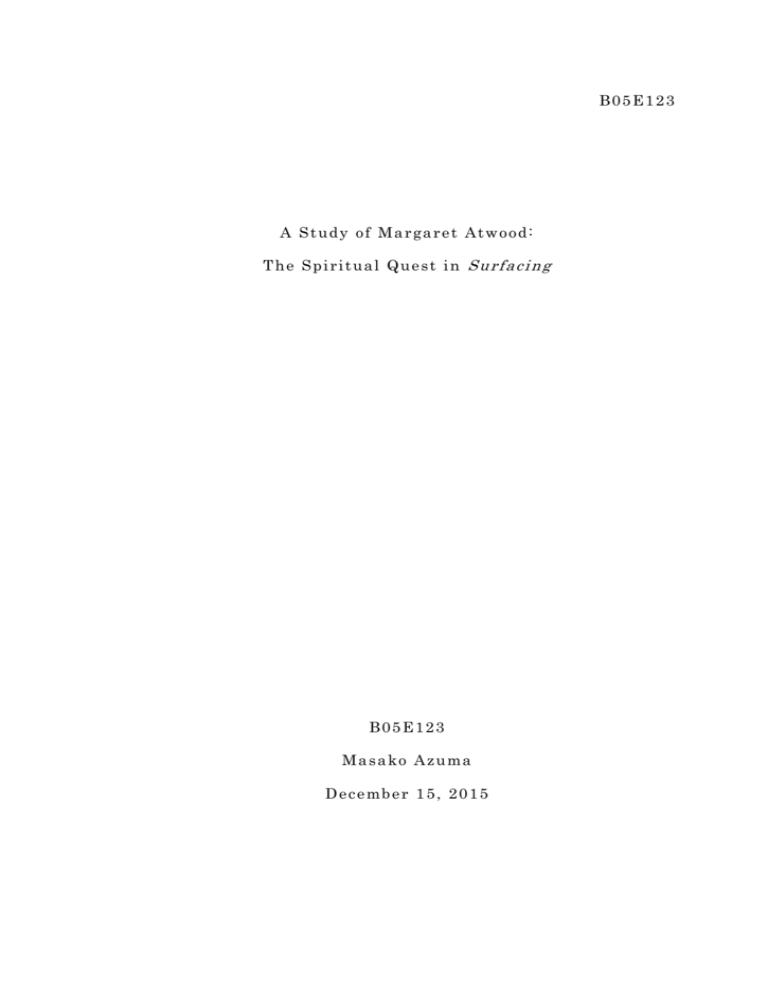
B05E123 A Study of Margaret Atwood: T h e S p i r i t u a l Q u e s t i n S u rf a ci n g B05E123 M a s a k o A z u ma D e c e mb e r 1 5 , 2 0 1 5 A Study of Margaret Atwood: T h e S p i r i t u a l Q u e s t i n S u rf a ci n g M a s a k o A z u ma A thesis s u b mi t t e d i n p a r t i a l f u l f i l l me n t o f t h e r eq u i r e m e n t s f o r t h e d e g r e e o f Bachelor of Arts and Sciences in the Department of Literature and Culture in English T o k y o W o m a n ’ s C h r i s ti a n U n i v e r s i t y D e c e mb e r 1 5 , 2 0 1 5 Table of Contents Introduction ............................................. 1 Chapter 1. The Awakening ........................ 3 Chapter 2. The First Step Toward R eb i r t h . . . . . . . . . . . . . . . . . . . . . . . . . . . . . . . . . . . . 9 Chapter 3. The Recovery of Maternity ....... 15 Conclusion ............................................. 19 Works Consulted ...................................... 22 1 Introduction The study of women’s writing has long been neglected by the male critical establishment both in academic circles and beyond. As a result, many women writers have either been unfairly neglected, or have been marginalized in some way so that their true importance has been overlooked. In the past, the internal conflicts involved in being a woman in a male-dominated society were larg ely ignored, and this affected our reading of women’s work. The time has come for a serious reassessment of women’s writing in light of what we understand today. The Canadian author Margaret Atwood is “one of the foremost female writers who focuses on the strength of women” (Watanabe 72, translation mine). Her novels and critical essays are worth examining because of her interesting ideas on feminism. In her nonfiction book entitled Second Words , Atwood states there is “an inevitable relationship between th e nationalism of Canada and the extension of women’s rights” (Atwood, Second Words 25). She believes that Canadians and women both have been oppressed minorities and that both have traditions which have been represented with images of subordination. A part of Atwood’s enterprise is to begin to rectify the effects of these representations. She seeks to add 2 Chapter 1: The First Step Toward Rebirth According to the Compact Oxford English Dictionary , a quest is “a long or arduous search.” The spiritual ques t of the protagonist of Surfacing , a 1972 Atwood novel which reveals her “feminist voice” (“Margaret Atwood”), begins with her journey toward her childhood home in the wilderness of northern Canada in search of her missing father who is presumed dead. Howe ver, the search is ultimately for herself; to discover and recover her own identity. The protagonist is a psychological suicide, a woman with no name, an artist with no art form and no past or tradition that she can recall correctly. She can neither “feel” nor communicate effectively. She has a lover whom she cannot love; she is a mother without a child, and a child without a mother. Her spiritual quest for rebirth parallels her search for her parents. In other words, the spiritual quest in Surfacing has both aspects of an internal search and an outward search. Each of these two aspects of the spiritual quest may be divided into two steps. The first step of the outward search is the search for her father. Through the search, the protagonist discovers how she has lost the ability to feel. It is the first step to being reborn. The first step, in other words, is the quest for rebirth guided by the power of her father. The second step is the quest for rebirth guided by the power of her mother. The 3 protagonist sea rches for “the gift” from her mother (187) because the power of her father is not enough for her to claim her power to refuse to be a victim. Concerning this spiritual experience, Carol P. Christ explains in the journal Signs : This awakening is especially poignant for women who, like Atwood’s protagonist, suppress their own feelings in order to acquiesce to male value systems. Rejection of a male-defined world may also open a woman to a full experience of the great powers, as happens to the heroine of Surfacing . (Christ 325) This “awakening” could be called “surfacing,” as the title of the novel indicates. The second step of the internal search involves moving from victimhood to power. The protagonist finally realizes that nothing will change as long as she sees herself as a powerless victim. This is the beginning of the protagonist’s quest toward healing and rebirth. At first, the protagonist believes she is innocent and virgin. She shields herself from the pain of confronting her true past. She makes up fictitious stories about how she was married and was separated from her child. She believes that her inability to feel and act is caused by this separation: I have to behave as though it doesn’t exist, because for me it can’t, it was taken away from me, expor ted, deported. A section of my own life, sliced off from me like a Siamese twin, my own flesh canceled. Lapse, 4 relapse, I have to forget. (Atwood, Surfacing 51) In this quotation, the protagonist regards herself as a victim, as someone who has suffered and must somehow try to forget her pain. 5 Works Consulted Atwood, Margaret. The Handmaid’s Tale . Toronto: McClelland and Stewart, 1985. Print. ---. Jijo no Monogatari [ The Handmaid’s Tale ]. Trans. Eiji Saitoh. Tokyo: Shineho-sha, 1995. Print. ---. Second Words: Selected Critical Prose . Toronto: Anansi, 1982. Print. ---. Surfacing . New York: Anchor, 1998. Print. ---. Survival: A Thematic Guide to Canadian Literature . Toronto: Anansi, 1972. Print. Christ, Carol P. “Margaret Atwood: The Surfacing of Women’s Spiritual Quest and Vision.” Signs: A Journal of Women in Culture and Society 2.2 (1976): 316-30. JSTOR . Web. 15 Oct. 2008. Gibson, Graeme. Eleven Canadian Novelists . Toronto: Anansi, 1972. Print. Grace, Sherrill E. “In Search of Demeter: The Lost, Silent Mother in Surfacing .” Margaret Atwood: Vision and Forms . Ed. Kathryn VanSpanckeren. Carbondale, IL: Southern Illinois UP, 1988. 33 -50. Print. “Margaret Atwood.” English-Canadian Writers . Athabasca U n.d. Web. 26 Apr. 2009. McCombs, Judith, and William Radki n, eds. Critical Essays on 6 Margaret Atwood . Boston: Hall, 1988. Print. “Quest.” Compact Oxford English Dictionary . 3rd ed. 2005. Print. Rigney, Barbara Hill. Women Writers: Margaret Atwood . London: Macmillan, 1987. Print. Rosenberg, Jerome H. Margaret Atwood . Boston: Twayne, 1984. Print. “Victim.” The Oxford English Dictionary . 2nd ed. 1989. Print. Watanabe, Toshio, ed. Yominaosu America Bungaku [ Rereading American Literature ]. Tokyo: Kenkyusha, 1996. Print. Weir, Lorraine. “Atwood in a Landscape.” Margaret Atwood: Language, Text, System . Ed. Sherrill E. Grace. Vancouver: U of British Columbia P, 1983. 25 -47. Print. Willet, Perry, ed. Victorian Women Writers Project . Indiana U, 10 Dec. 2002. Web. 27 Apr. 2009 Sample First Page of an Introduction, Linguistics Essay Introduction It is generally believed that “voice” is one of the important categories when we consider English grammar. There are two voice systems in English: the active and the passive. The relationship between active and passive is connected to the relationship between the agent and the patient, or subject and referent (Huddleston, Introduction 438). Voice is a grammatical category that makes it possible to view the action of a sentence in either of two ways, without change in the facts reported (Quirk et al. 159). Therefore it is said that the passive voice can be rewritten from the active voice. However, this is not completely correct, because there are active sentences that do not correspond to the passive, and passive sentences that do not have active equivalents. Besides, though we can change sentences from the passive voice to the active voice, there can be subtle important differences in the meaning. Thus, we can see that the voice system is very complicated; although there are rules, there are also many exceptions or other factors that should be seriously considered. The voice system is affected by a large number of matters, not only syntactic but also semantic. The purpose of this essay is to investigate the voice system and the possible reasons that active or passive are used in present day journalistic English. 1
